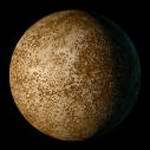Mercury Attracts Researchers: NASA Launches Space Satellite to Find Unique Information

A NASA space satellite set to launch next week is dedicated to finding information about Mercury. It is Dr. Konstanin Kabin's job to predict what the man-made satellite will encounter when it arrives at the closest planet to our sun.
A researcher in the University of Alberta Department of Physics, Kabin studies in the field of numerical magnetohydrodynamic (MHD) modelling, which means he does theoretical thinking, crunches numbers, and then uses supercomputers to create 3D images of Mercury's space environment.
"Mercury is truly unique," he said. "It's relatively small, it has an unusual chemical composition, its orbit is eccentric, and it doesn't have substantial atmosphere or ionosphere. However, it does have a permanent magnetic field, the origin of which has yet to be explained."
Kabin's research colleagues at the University of Michigan used his numerical MHD model when they built a fast-imaging plasma spectrometry instrument (FIPS), which will travel aboard the NASA satellite and send information about Mercury back to Earth.
"They need to have a rough idea of what they are going to measure when they get to Mercury. I hope my model has given them a good idea of this," said Kabin, who co-authored On the space environment of Mercury, a paper published in Advances in Space Research.
All of Kabin's data on Mercury comes from information gathered by Mariner 10, a NASA-built spacecraft that did three fly-bys of Mercury in the mid-'70s. Scheduled to launch Aug. 2 of this year, MESSENGER is a NASA satellite that scientists expect will fly by Mercury three times and then begin orbiting the planet for a year in 2011. In 2007, the European Space Agency is planning to launch a satellite, Bepi Columbo, that will also explore the space environment around Mercury.
"We hope these two missions will provide us with much more accurate measurements of Mercury's composition, magnetic field, and plasma environment--we really have very little data to go on right now," Kabin said.
In particular, he is interested in the fact that Mercury, due to its proximity to the sun, is vulnerable to huge solar flares.
"On rare occasions--maybe once a year--the flares are so powerful that they collapse Mercury's magnetosphere entirely and bombard the planet with solar wind particles," he said. "Earth's magnetic field is about 100 times larger than Mercury's magnetic field, and we're much farther from the sun, so when we study Mercury we should be able to see magnetic field configurations that we could never see on Earth."
Kabin believes that gathering information about Mercury's space environment may provide valuable insights into Earth's space environment and improve our understanding of such things as magnetic storms, power grid fluctuations and northern lights.
He added that, for most scientists, the fundamental motivation in studying Mercury is to get a better idea of its chemical composition, which may provide answers to several critical questions about the formation and evolution of terrestrial planets.
"Essentially, we need more data to explain why Mercury formed close to the sun while gas giants such as Jupiter and Saturn formed far away from the sun, with Earth somewhere in between," he said. "This should help us to get a better understanding of the initial composition of the early solar system and how Earth-type planets--where life may exist--may be formed around other stars."
Related link – external
The NASA MESSENGER website: www.ksc.nasa.gov/elvnew/messenger/
Source: University of Alberta
















